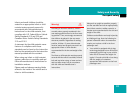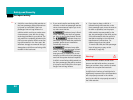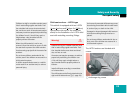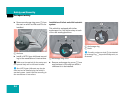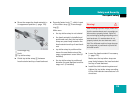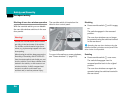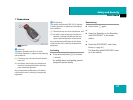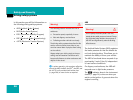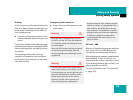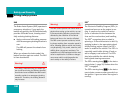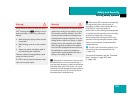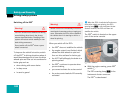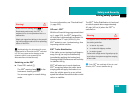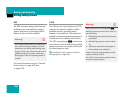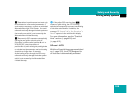
99
Safety and Security
Driving safety systems
Braking
At the instant one of the wheels is about to
lock up, a slight pulsation can be felt in the
brake pedal, indicating that the ABS is in
the regulating mode.
̈ Keep firm and steady pressure on the
brake pedal while experiencing the pul-
sation.
Continuous, steady brake pedal pressure
yields the advantages provided by the ABS,
namely braking power and ability to steer
the vehicle.
The pulsating brake pedal can be an
indication of hazardous road conditions
and functions as a reminder to take extra
care while driving.
Emergency brake maneuver
̈ Keep continuous full pressure on the
brake pedal.
Off-road – ABS
With the off-road driving program switched
on (
୴ page 253), the ABS designed for
off-road use is automatically activated.
When applying the brakes at speeds below
approximately 18 mph (30 km/h), the
front wheels are locked cyclically to short-
en the braking distance (dig-in effect). This
affects steering the vehicle.
For more information, see “Practical hints”
(
୴ page 399).
Warning! G
When the ABS is malfunctioning, the BAS,
the ESP
®
, and the 4-ETS are also switched
off. The basic driving and braking functions
are still available.
When the ABS is malfunctioning, the wheels
may lock during hard braking, reducing
steering capability and extending the brak-
ing distance.
Warning! G
The ABS cannot prevent the natural laws of
physics from acting on the vehicle, nor can
it increase braking or steering efficiency be-
yond that afforded by the condition of the
vehicle brakes and tires or the traction
afforded. The ABS cannot prevent acci-
dents, including those resulting from
excessive speed in turns, following another
vehicle too closely, or hydroplaning. Only a
safe, attentive, and skillful driver can pre-
vent accidents. The capabilities of an ABS
equipped vehicle must never be exploited in
a reckless or dangerous manner which
could jeopardize the user’s safety or the
safety of others.



